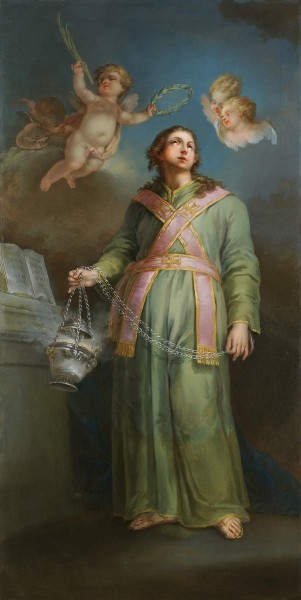The artist is Belsky

In the 1980 timing catalog, there were no time, for the first time were published by Tatyana Ilyina and Svetlana Rimskoy-Korsakova. Were considered the works of the school of Andrei Matveev (?) and dated 1730s.
The authors united the images “John the Theologian” and “Archbiancenacon Stefan” into the same group with the images “Section”, “Annunciation”, “Christmas”, “Holy Catherine”, also entered the timing of the Armenian Church three years later, despite some stylistic stylistic church Differences. “… the general iconographic type can be traced in both female and male figures. All the paintings are also united by some ecstasy of expression, the state of a stopped movement, transmitted by the artist in each composition, regardless of the plot. “.
In the “inventory” of the Church of the Nativity of Christ, the image of “John the Theologian” is mentioned on the sands of 1808, and in the inventory of 1848 – “Archdikon Stefan”. The icons were in the temple as wall images of the chapter of the Nativity of the Virgin. “The Mother of God”, “John the Theologian” and “Archdikon Stefan” are united by the plot: during the beating of Stefan “in the distance, on the elevation, the Mother of God stood with the holy apostle John the Theologian and diligently prayed for the martyr”.
(Svetlana Moiseeva. Belian artists. SPb, 2019. With. 42)
+ About the restoration of the work
– Hide the text about restoration
The state of safety before restoration:
During his life in the Russian Museum, from the moment of receipt from the Armenian Church (and this is almost 90 years), the paintings “Archdikon” and “John the Theologian” have never been in restoration. It can be assumed that during existence in the Church, paintings were not always stored in ideal conditions, in compliance with the temperature and humidity regime adopted in the museum. This led to the development of rigid soil craquelure and a colorful layer that caused deformation of the base. Author’s canvases sagged, which caused the appearance of strict breaks on the prints of the subframe planks. In addition, on the back of the canvases along the lower edge, traces of divorces that probably arose due to the wetting of the lower edges of the paintings were discovered. On the front side in these places, the colorful layer was completely destroyed. The paintings had dilapidated narrow edges that could not fully fix them on the subframe, in the lower corners at the ribs of the subframe the author’s canvas was damaged. Both paintings were covered with numerous multi -time layers of varnish. Over time, the lacquer film lost transparency, yellowed, completely hiding the author’s color of painting.
Complex of the events:
Before the restoration, a comprehensive study of the works was carried out, which includes a chemical analysis of all layers, the study of the varnish film in UV rays. Samples for mycological analysis were taken on the back of both canvases, which showed the presence of living micromycetes. This confirmed the assumption of the possible wetting of paintings during existence in the church and required the appropriate processing of the canvases.
During the restoration process, a colorful layer and soil was strengthened, the surface was leveled, laid in the plane of fracture and craquelure. The state of the author’s canvas in each case made it possible to do without duplication of the foundation on a new canvas, which is quite rare for paintings by the 18th century, but it is very important for maintaining the primordiality and the possibility of further studying the monument. Restoration edges were brought to the paintings, the works are stretched on new subframes.
The removal of the late yellowed varnish layers revealed a completely unexpected author’s flavor. The saturation and purity of color and the subtlety of picturesque sections appeared, which allowed us to talk about the characteristics of the master’s painting and conduct a stylistic comparative analysis of the works. In addition, in the process of opening under a varnish film, very old recordings and fragments of correspondence were discovered that change the composition. Additional studies were required in the IR Videokanal and in UV rays, which gave interesting information about the history of the creation of paintings, the author’s change in the drawing and composition, the position of the hands, the pattern of clothes.
At the final stage of restoration, restoration tints were made and the paintings are covered with a protective layer of varnish.
One of the important results of restoration was the disclosure of the true author’s color of works characterizing Belsky as an excellent painter. In addition, a huge material was obtained for a stylitic and coloristic comparison, which is very important for the attribution of works. The restoration not only ensured their safety, but also gave great research material to study the artist’s work.
Keeping a story. Restoration workshop of the Russian Museum – 100 years. SPb, 2022. With. 92-93.
Leave a Reply